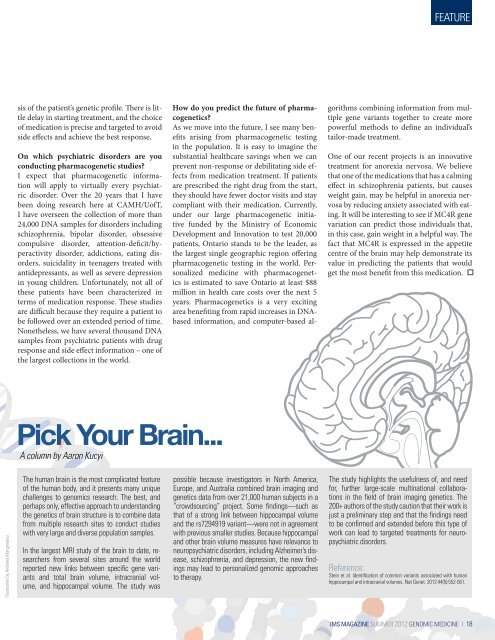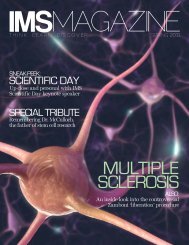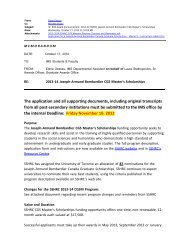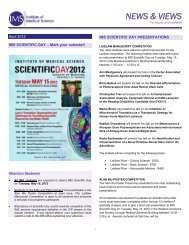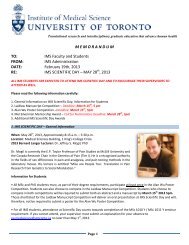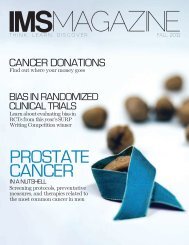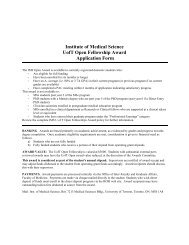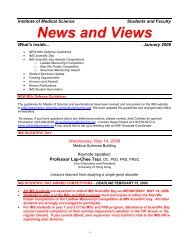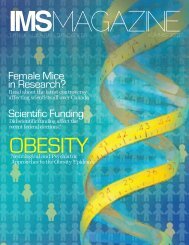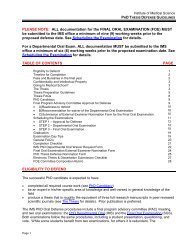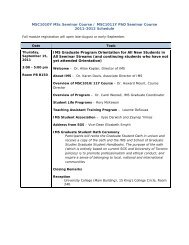IMS Magazine - Summer 2012 edition in PDF format - Institute of ...
IMS Magazine - Summer 2012 edition in PDF format - Institute of ...
IMS Magazine - Summer 2012 edition in PDF format - Institute of ...
Create successful ePaper yourself
Turn your PDF publications into a flip-book with our unique Google optimized e-Paper software.
FEATURE<br />
sis <strong>of</strong> the patient’s genetic pr<strong>of</strong>ile. There is little<br />
delay <strong>in</strong> start<strong>in</strong>g treatment, and the choice<br />
<strong>of</strong> medication is precise and targeted to avoid<br />
side effects and achieve the best response.<br />
On which psychiatric disorders are you<br />
conduct<strong>in</strong>g pharmacogenetic studies?<br />
I expect that pharmacogenetic <strong>in</strong><strong>format</strong>ion<br />
will apply to virtually every psychiatric<br />
disorder. Over the 20 years that I have<br />
been do<strong>in</strong>g research here at CAMH/U<strong>of</strong>T,<br />
I have overseen the collection <strong>of</strong> more than<br />
24,000 DNA samples for disorders <strong>in</strong>clud<strong>in</strong>g<br />
schizophrenia, bipolar disorder, obsessive<br />
compulsive disorder, attention-deficit/hyperactivity<br />
disorder, addictions, eat<strong>in</strong>g disorders,<br />
suicidality <strong>in</strong> teenagers treated with<br />
antidepressants, as well as severe depression<br />
<strong>in</strong> young children. Unfortunately, not all <strong>of</strong><br />
these patients have been characterized <strong>in</strong><br />
terms <strong>of</strong> medication response. These studies<br />
are difficult because they require a patient to<br />
be followed over an extended period <strong>of</strong> time.<br />
Nonetheless, we have several thousand DNA<br />
samples from psychiatric patients with drug<br />
response and side effect <strong>in</strong><strong>format</strong>ion – one <strong>of</strong><br />
the largest collections <strong>in</strong> the world.<br />
How do you predict the future <strong>of</strong> pharmacogenetics?<br />
As we move <strong>in</strong>to the future, I see many benefits<br />
aris<strong>in</strong>g from pharmacogenetic test<strong>in</strong>g<br />
<strong>in</strong> the population. It is easy to imag<strong>in</strong>e the<br />
substantial healthcare sav<strong>in</strong>gs when we can<br />
prevent non-response or debilitat<strong>in</strong>g side effects<br />
from medication treatment. If patients<br />
are prescribed the right drug from the start,<br />
they should have fewer doctor visits and stay<br />
compliant with their medication. Currently,<br />
under our large pharmacogenetic <strong>in</strong>itiative<br />
funded by the M<strong>in</strong>istry <strong>of</strong> Economic<br />
Development and Innovation to test 20,000<br />
patients, Ontario stands to be the leader, as<br />
the largest s<strong>in</strong>gle geographic region <strong>of</strong>fer<strong>in</strong>g<br />
pharmacogenetic test<strong>in</strong>g <strong>in</strong> the world. Personalized<br />
medic<strong>in</strong>e with pharmacogenetics<br />
is estimated to save Ontario at least $88<br />
million <strong>in</strong> health care costs over the next 5<br />
years. Pharmacogenetics is a very excit<strong>in</strong>g<br />
area benefit<strong>in</strong>g from rapid <strong>in</strong>creases <strong>in</strong> DNAbased<br />
<strong>in</strong><strong>format</strong>ion, and computer-based algorithms<br />
comb<strong>in</strong><strong>in</strong>g <strong>in</strong><strong>format</strong>ion from multiple<br />
gene variants together to create more<br />
powerful methods to def<strong>in</strong>e an <strong>in</strong>dividual’s<br />
tailor-made treatment.<br />
One <strong>of</strong> our recent projects is an <strong>in</strong>novative<br />
treatment for anorexia nervosa. We believe<br />
that one <strong>of</strong> the medications that has a calm<strong>in</strong>g<br />
effect <strong>in</strong> schizophrenia patients, but causes<br />
weight ga<strong>in</strong>, may be helpful <strong>in</strong> anorexia nervosa<br />
by reduc<strong>in</strong>g anxiety associated with eat<strong>in</strong>g.<br />
It will be <strong>in</strong>terest<strong>in</strong>g to see if MC4R gene<br />
variation can predict those <strong>in</strong>dividuals that,<br />
<strong>in</strong> this case, ga<strong>in</strong> weight <strong>in</strong> a helpful way. The<br />
fact that MC4R is expressed <strong>in</strong> the appetite<br />
centre <strong>of</strong> the bra<strong>in</strong> may help demonstrate its<br />
value <strong>in</strong> predict<strong>in</strong>g the patients that would<br />
get the most benefit from this medication.<br />
Pick Your Bra<strong>in</strong>...<br />
A column by Aaron Kucyi<br />
Illustration by Andreea Marg<strong>in</strong>eanu.<br />
The human bra<strong>in</strong> is the most complicated feature<br />
<strong>of</strong> the human body, and it presents many unique<br />
challenges to genomics research. The best, and<br />
perhaps only, effective approach to understand<strong>in</strong>g<br />
the genetics <strong>of</strong> bra<strong>in</strong> structure is to comb<strong>in</strong>e data<br />
from multiple research sites to conduct studies<br />
with very large and diverse population samples.<br />
In the largest MRI study <strong>of</strong> the bra<strong>in</strong> to date, researchers<br />
from several sites around the world<br />
reported new l<strong>in</strong>ks between specific gene variants<br />
and total bra<strong>in</strong> volume, <strong>in</strong>tracranial volume,<br />
and hippocampal volume. The study was<br />
possible because <strong>in</strong>vestigators <strong>in</strong> North America,<br />
Europe, and Australia comb<strong>in</strong>ed bra<strong>in</strong> imag<strong>in</strong>g and<br />
genetics data from over 21,000 human subjects <strong>in</strong> a<br />
“crowdsourc<strong>in</strong>g” project. Some f<strong>in</strong>d<strong>in</strong>gs—such as<br />
that <strong>of</strong> a strong l<strong>in</strong>k between hippocampal volume<br />
and the rs7294919 variant—were not <strong>in</strong> agreement<br />
with previous smaller studies. Because hippocampal<br />
and other bra<strong>in</strong> volume measures have relevance to<br />
neuropsychiatric disorders, <strong>in</strong>clud<strong>in</strong>g Alzheimer’s disease,<br />
schizophrenia, and depression, the new f<strong>in</strong>d<strong>in</strong>gs<br />
may lead to personalized genomic approaches<br />
to therapy.<br />
The study highlights the usefulness <strong>of</strong>, and need<br />
for, further large-scale mult<strong>in</strong>ational collaborations<br />
<strong>in</strong> the field <strong>of</strong> bra<strong>in</strong> imag<strong>in</strong>g genetics. The<br />
200+ authors <strong>of</strong> the study caution that their work is<br />
just a prelim<strong>in</strong>ary step and that the f<strong>in</strong>d<strong>in</strong>gs need<br />
to be confirmed and extended before this type <strong>of</strong><br />
work can lead to targeted treatments for neuropsychiatric<br />
disorders.<br />
Reference:<br />
Ste<strong>in</strong> et al. Identification <strong>of</strong> common variants associated with human<br />
hippocampal and <strong>in</strong>tracranial volumes. Nat Genet. <strong>2012</strong>;44(5):552-561.<br />
<strong>IMS</strong> MAGAZINE SUMMER <strong>2012</strong> GENOMIC MEDICINE | 18


